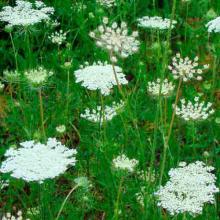Daucus carota
Common name:
Queen Anne's lace
Genus:
Daucus
Family:
Apiaceae
Order:
Apiales
Daucus carota
Common name:
Queen Anne's lace
Genus:
Daucus
Family:
Apiaceae
Order:
Apiales
Daucus carota
Common name:
Queen Anne's lace
Genus:
Daucus
Family:
Apiaceae
Order:
Apiales
Genus (Plantae): Daucus
Daucus is a worldwide genus of herbaceous plants of the celery family Apiaceae of which the best-known species is the cultivated carrot. Daucus has about 25 species. The oldest carrot fossil is 1.3 Ma, and was found in Madeira island (Atlantic ocean).
Description
Members of Daucus are distinguished within the family Apiaceae by their leaves which are 2–3 pinnatisect with narrow end sections. The genus primarily consists of biennial plants but also includes some annual plants and some perennial herbs. All Daucus have bristly stems. The inflorescences are umbels. The flowers are mostly white, with bracts and bracteoles. The petals may be pure white, reddish, pinkish or yellowish. They are emarginate above and have pointed, wrapped lobules. The petals are often unequal in size, with petals at the outermost edge of the inflorescence often being larger. The fruit is an ovoid to ellipsoidal schizocarp, cylindrical or compressed, with ciliate primary ribs and secondary ribs with a row of hooked spines.[2] Some species have a small pale or white edible taproot, similar to a radish, which may or may not be bitter in taste.
Reference: Wikipedia

